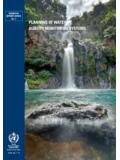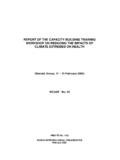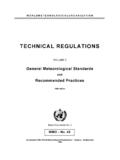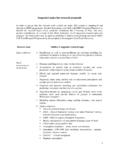Transcription of Current problems of hydrological networks design …
1 1 Current problems of hydrological networks design and optimization . Introduction A hydrological network is composed of a group of stations (gauges) that are designed and operated to make observations under special observation programs and address a single objective or a set of interrelated objectives. Observation data collected in the network can be used, for example, only for a water resources assessment, a development plan, a project design , or for designing flood protection measures including flood forecasting. In most cases, however, a hydrological network is designed for addressing a set of interrelated objectiv es. In this case, a network u sually consists of several typ es of gau ges and stations.
2 For example, a flood-warning network might include both stream and stage gauges, meteorological stations, precipitation network , snow courses and agrometeorological stations and posts providing information on the state of soil cover (soil water storage at various horizons, soil freezing depth, etc.). Today, more than ever before, the range of hydrological networks objectives and the uses of collected data has extended. Along with conventional uses of hydrological information, such as water resour ces assessment, pro ject design , water resources p lannin g, h ydro logical forecastin g and w ater qu ality control, such applications of hydrological data as environmental monitoring, flow accounting and monitoring of water quality in transboundary water bodies, development of local hydrological forecasting and flood-warning systems, monitoring of water allocation processes and provision of data for management of water utilization systems are gaining in importance.
3 hydrological network optimization is a slow and evolutionary process, starting with a minimum number of station s, and increasing gradually (as necessary) un til an optimum network is attain ed. An optimum network is achieved when the amount and quality of data collected and information processed is econom ically justifiable and it meets the users needs. 1. Evolution of methods for hydrological network design and optimization Most consideration to the issues of hydrological network design and optimization was given in the USA, Russia and Canada. The most comprehensive review of the history of network design since the 1930 s up to the present was provided by the scientists from Trent University (Watershed Science Centre)( Richard S.)
4 Pyrce, 2004), some of which is cited here. Initially, the design of early hydrological network was governed almost exclusively for some specific 2 project, for example, flood mitigation, irrigation or dam construction. The increased need for data during the Second World War, for economic efforts in support of the war or for military operations, led to the realization that something more was needed than an ad hoc series of hydrological stations installed without much reference to one another. This led to the development of a rationale for the design of hydrological networks based on a quasi-uniform areal coverage to take account of the particular characteristics of the element being measured.
5 However, much of the literature on network design at that time concentrated on offering practical advice based on experience. Nemec and Askew (1986) referred to this as the basic pragmatic approach . As early as the late 1930 s, the first attempts were made to use statistical estimates of error in computing areal precipitation as a basis for choosing optimum gauge density (Wilm et al., 1939). In Russia, the first attempts at network design were made at the State hydrological Institute (SHI). In 1934, the Director of SHI V. Glushkov proposed an approach based on a so-called geographic- hydrological method (Glushkov, 1933). One of the principles for network design was to satisfy spatial and linear interpolation of hydrological regime elements.
6 This approach was further developed by I. Karasev (1968, 1972, 1980,1988). Main principles and criteria for establishing an optimum network suggested by Karasev are based on continuous representation of fields of hydrological elements. Optimum network design on rivers with natural or slightly disturbed regimes is based on continuous representation of a field of hydrological elements which can be assessed by zonal stream-flow characteristics. This can be achieved by establishing most of the stations so that they close zonal-representative areas of watersheds (Azr). Density of stations, distance between central points of the basins, should offer a possibility to accurately estimate discharge characteristics in ungauged basins.
7 At the same time, stations should be located far enough from each other so as to detect changes (gradient) of a norm of a hydrological element. On the assumption of homogeneity of the field of elements within a hydrological region, two main criteria, correlation and gradient, for watershed area closed by a station were suggested. Optimum watershed area Ao covered by one station should satisfy the follo win g relation: Аgr Ao < Ac, Where Agr и Ac are the gradient and correlation criteria satisfying correspondingly the smallest and the largest d istance between th e centres of the basins und er con sideration. On rivers with watershed area A < Ao (small azonal) and for large rivers with A > Ao, network s ar e designed depending on the aims of studying conditions of formation and forecasting.
8 In most cases, optimum value of Aо corresponds to medium watersheds for which zonal type of 3 discharge form ation is ch aracteristic. For small (azonal) rivers with watershed area A < Aо, large (polyzonal) rivers, with A > A , and rivers with human-affected discharge, a site by site principle depending on the structure river systems would be justifiable. Most early approaches to planning and optimization of hydrological networks were based on a conclusion that a network should be comprised of two parts: a group of base stations including those with continuous time-series, and a group of secondary stations to be operated for relatively short periods (5 to 10 years) until sufficient data are collected to provide reliable correlation with factors observed at base stations.
9 Optimum networks should also provide methods for determining with any required accuracy streamflow characteristics at any ungauged point. In the late 1970 s and 1980 s, statistical approaches and regression analysis had widespread application in network design (Moss and Karlinger, 1974; Benson and Matalas, 1967) Moss and Tasker (1991) compared and tested two based network design technologies: 1) the network Analysis for Regional Information (NARI) (Moss et al., 1982; Moss and Tasker, 1991)) and 2) the network Analysis Using Generalized Least Squares (NAUGLS). Both methods have a common objective: to maximize regional information within a limited budget and time horizon.
10 NARI evolved to fill a need highlighted by a national study of the Geological Surveys s streamflow data collection program (Benson and Carter, 1973). The NARI method is based on a regional regression approach (Benson and Matalas, 1967) for the definition of streamflow parameters, and its output is and evaluation of the likelihood of various lev els of improvemen t in th e regression relation s th at may that may b e obtained b y the collection of additional streamflow data. The strength of this approach is that a stream gauge manager can develop a network strategy based on any one of a combination of stations. The NAUGLS procedure used a generalized least square estimator proposed by Stediner and Tasker (1985) to estimate parameters of a regression model of stream flow characteristics on physiographic characteristics.











